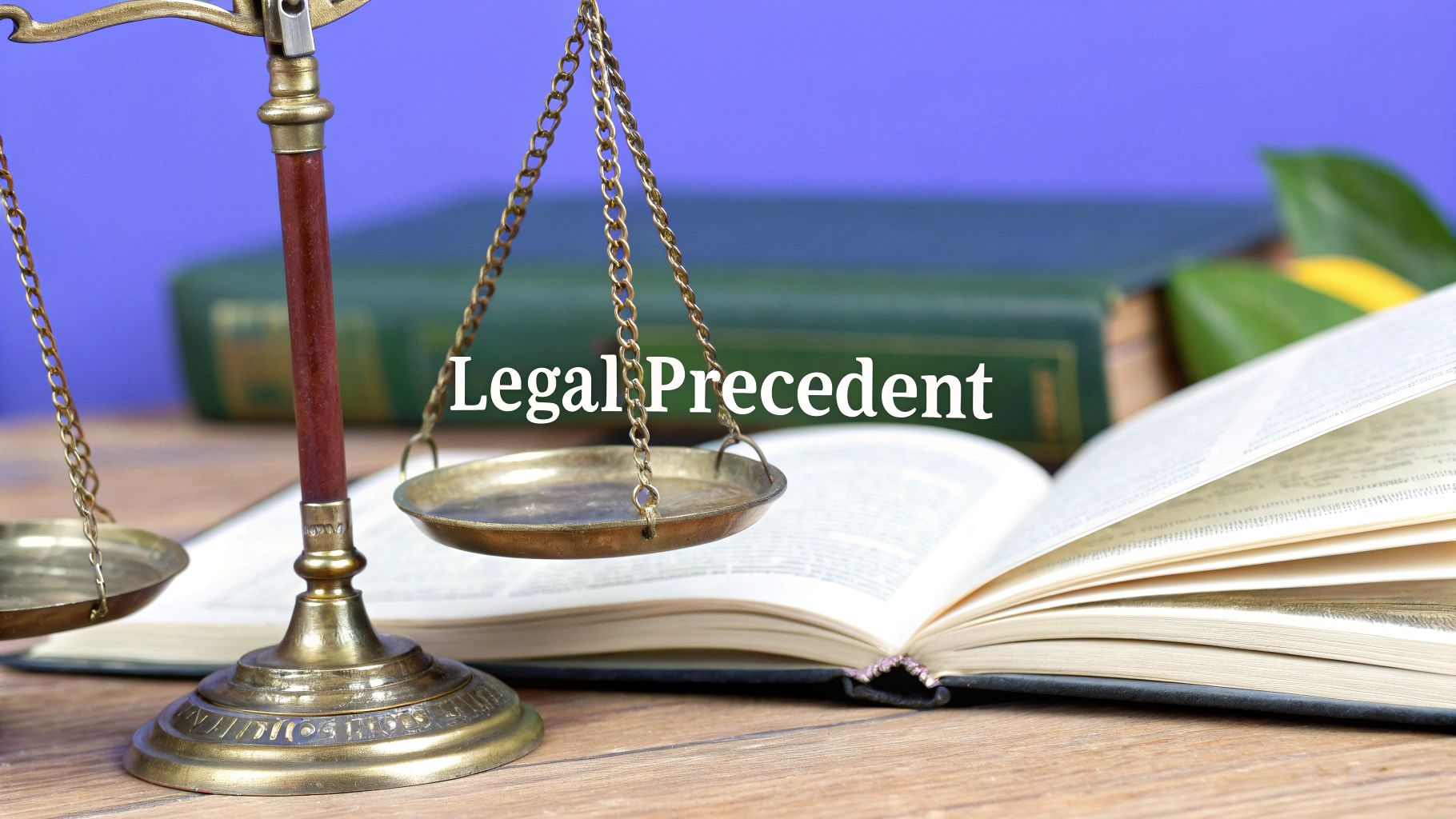
Ever felt like the legal world operates on a set of unwritten rules? Well, some of them are written, just not in a single rulebook. They’re found in past court decisions, and this concept is known as legal precedent.
Think of it like a seasoned chef perfecting a recipe. Once they nail the ingredients and method, that recipe becomes the gold standard for anyone in the kitchen who wants a consistent, delicious result. In the legal system, precedent is how we ensure fairness and predictability. It’s the law’s way of saying, "This worked before, so we’ll follow the same logic now."
What Is a Legal Precedent?
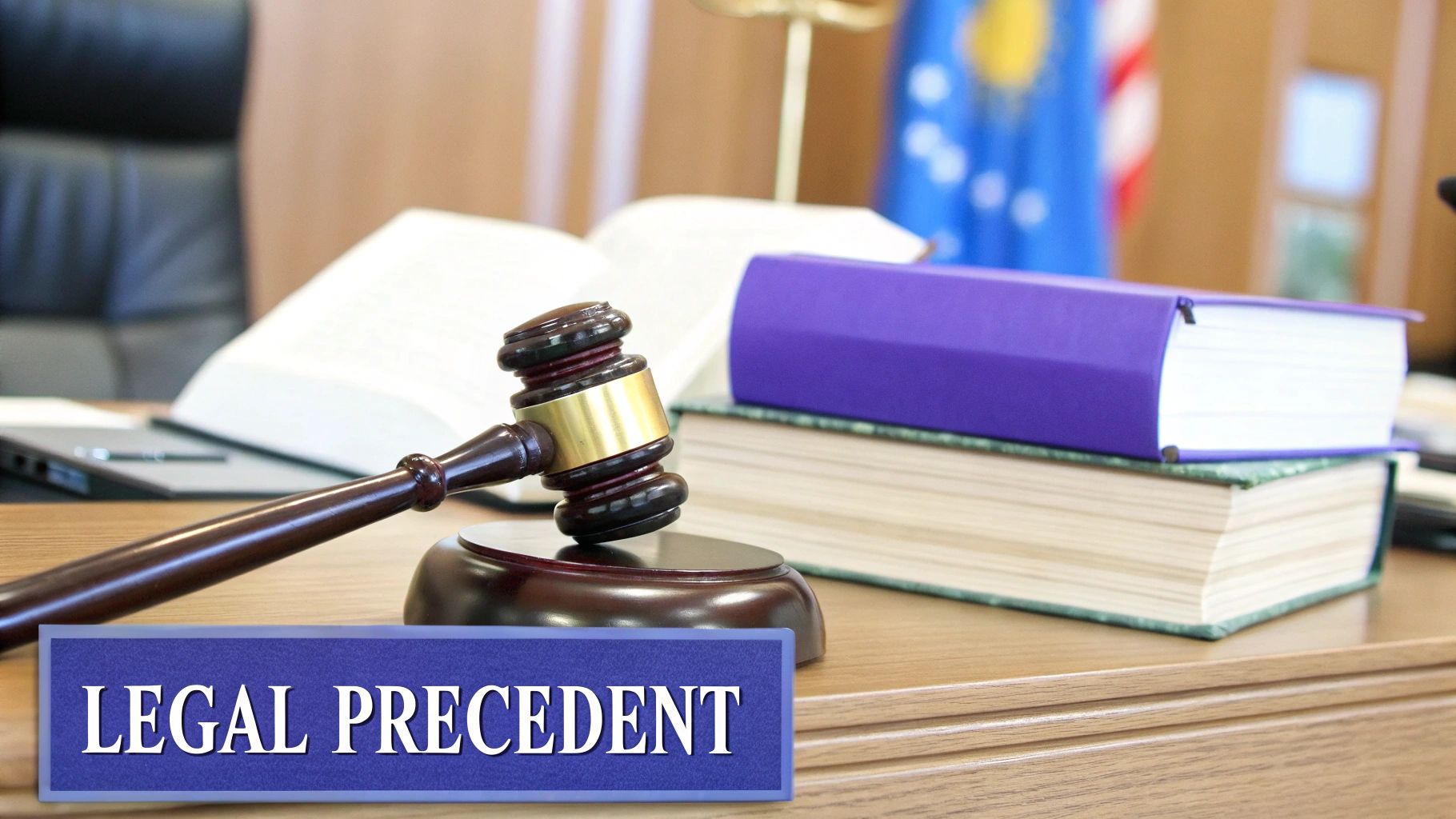
At its heart, legal precedent is the guiding principle that underpins our justice system. This idea is captured in a Latin term, stare decisis, which translates to "to stand by things decided." It’s a simple but powerful instruction: judges should respect the rulings made in previous, similar cases.
This approach isn’t used everywhere. It’s the cornerstone of common law systems, like those in the United States, the United Kingdom, and Canada. These legal traditions rely heavily on the accumulated wisdom of past judicial decisions to shape current ones.
The Purpose of Stare Decisis
So, why bother with stare decisis? The main goal is to build a stable and consistent legal framework. Without it, every court ruling could be completely different, depending solely on the judge’s personal views. Precedent helps the law evolve in a measured, thoughtful way instead of lurching from one extreme to another.
By following established decisions, the legal system promotes fairness, ensures that the law is applied evenly to all individuals, and provides a predictable foundation for citizens and businesses to operate.
This stability is absolutely vital. Imagine trying to run a business if the rules for what constitutes a breach of contract changed with every new lawsuit. It would be chaos. Precedent provides the reliable guideposts we all need to navigate our legal and commercial lives.
Grasping this concept is crucial for understanding how the law works. For a closer look at other fundamental legal ideas, you can explore our guide explaining common legal terms.
Key Precedent Concepts at a Glance
To make these ideas a bit clearer, here's a quick breakdown of the core concepts we've just touched on.
| Concept | Simple Explanation | Why It Matters |
|---|---|---|
| Legal Precedent | A past court decision used to guide future, similar cases. | Ensures the law is applied fairly and consistently. |
| Stare Decisis | The legal principle of "standing by things decided." | Compels judges to follow precedent, promoting stability. |
| Common Law | A legal system built on judicial decisions (precedents). | Forms the basis of law in countries like the US and UK. |
This table sums up the foundation, but there's a bit more to it. Not all past court decisions have the same weight. The legal system makes a critical distinction between precedents that are mandatory and those that are merely influential. We'll dig into that difference next.
Binding vs. Persuasive Precedent
So, we have a general idea of what precedent means. But here’s where it gets interesting: not all precedents are created equal. The legal system doesn’t treat every past court decision with the same weight. Instead, each ruling falls into one of two buckets, and each has a very different level of sway over a judge handling a case today.
This distinction is absolutely fundamental to how our courts work. The court system’s own hierarchy is what decides whether a past decision is a non-negotiable rule or just a helpful suggestion. Getting this difference is the key to understanding how lawyers build their arguments and why they choose to cite specific cases.
The Power of Binding Precedent
A binding precedent is a decision from a higher court within the same jurisdiction that a lower court must follow. It’s not optional. Think of it as a direct order from a manager to an employee. The employee doesn’t get to decide whether the instruction is a good idea; they are bound to follow it to the letter.
For example, a ruling from the Ohio Supreme Court is binding on all lower state courts in Ohio, like a local trial court in Cleveland. If the state’s highest court has already settled a specific issue in a contract dispute, that Cleveland judge has no choice but to apply the exact same legal reasoning to a similar case that lands in their courtroom. This creates a clear, top-down structure that keeps the law consistent across the state.
This infographic shows the relationship between stare decisis—the core principle of standing by decided cases—and the two types of precedent that flow from it.
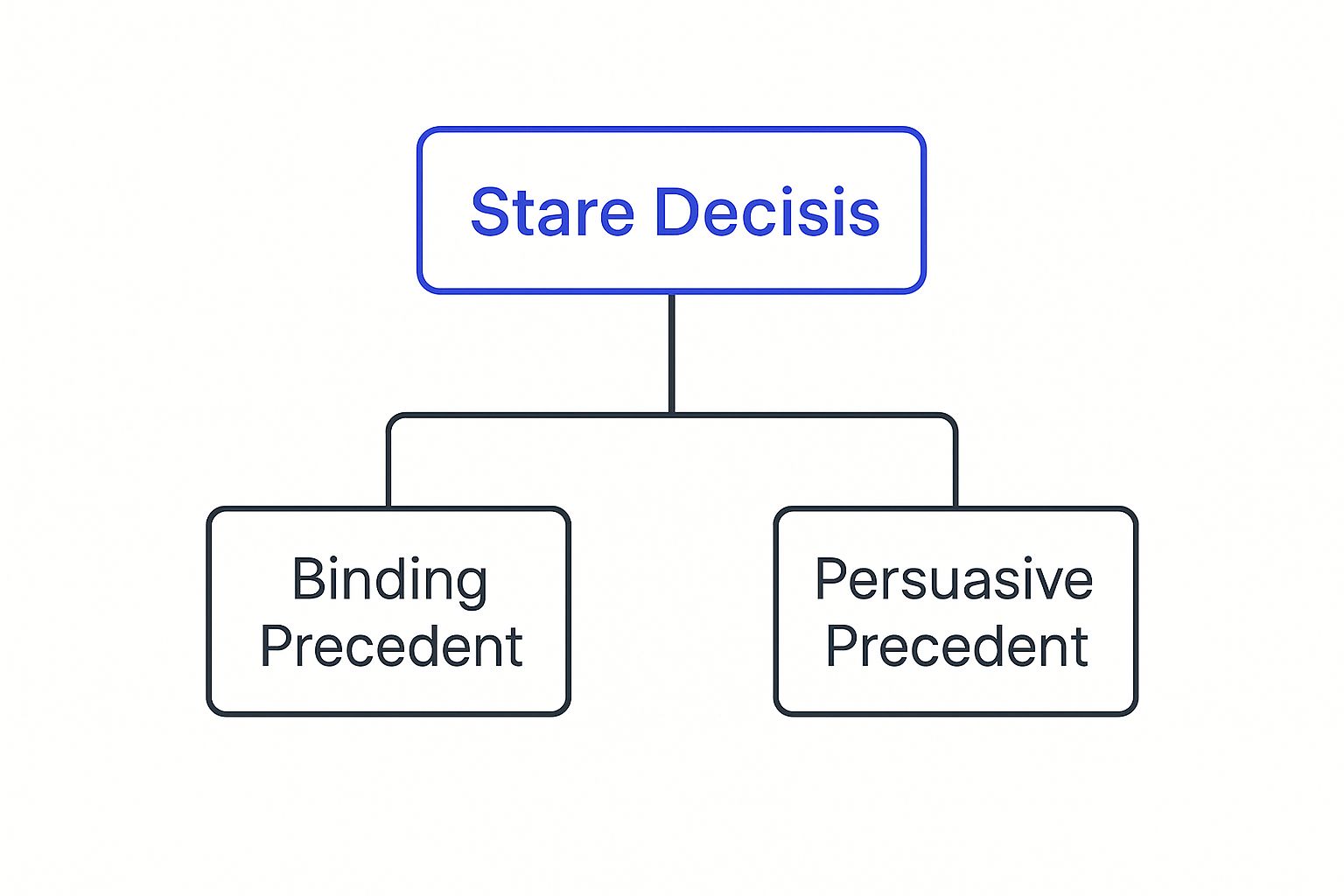
As the diagram illustrates, both binding and persuasive precedent are direct results of this commitment to stand by what has already been decided.
The Influence of Persuasive Precedent
On the other hand, persuasive precedent is more like well-reasoned advice from a respected colleague. It’s not a direct command, but its logic and thorough analysis can be highly influential. A judge is free to look at these decisions for guidance but isn't required to follow them.
This type of precedent often comes from a few different places:
- Courts in other jurisdictions (for instance, a Florida Supreme Court ruling being cited in an Ohio case).
- Lower courts in the same jurisdiction that offer a fresh or novel argument.
- Statements made in a judicial opinion that weren't strictly necessary for the final ruling (what lawyers call dicta).
Let’s go back to our Cleveland judge. They aren’t bound by Florida law. But what if the Florida Supreme Court just handled a really complex tech contract dispute—the kind of case that has no equivalent in Ohio law yet? The Ohio judge might find the Florida court's reasoning incredibly helpful and choose to adopt a similar approach.
The difference between binding and persuasive precedent isn't just an academic exercise; it's the very engine of judicial decision-making. Legal scholars estimate that roughly 60-70% of cases lean directly on precedent to resolve legal questions, which just goes to show how vital it is. You can discover more about how courts apply precedent from Cornell Law School.
Ultimately, binding precedent provides stability and predictability, while persuasive precedent allows the law to innovate and adapt. It’s how good ideas and sound legal reasoning can travel across state lines and help shape the law for the better.
How Courts Interpret Precedent
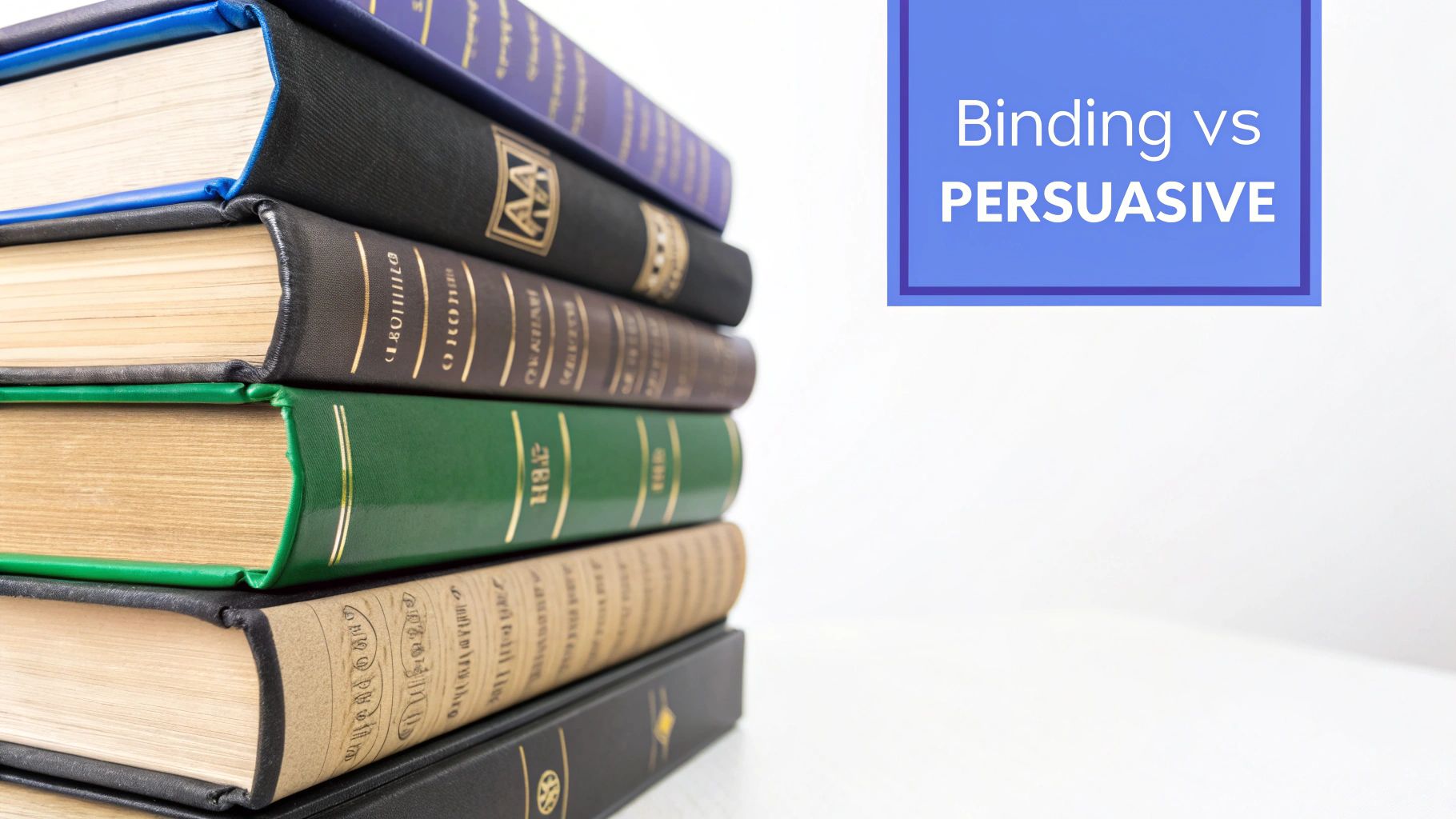
So, what does precedent really mean in practice? It's more than just a judge digging up an old case and rubber-stamping the outcome. They don't just blindly copy past rulings. Instead, they actively engage with them, figuring out how a historical decision fits—or doesn't fit—the unique situation they're facing today.
This interpretive dance is what keeps the law from becoming a stuffy, outdated relic. It allows our legal system to stay grounded in proven logic while still adapting to new technologies, societal norms, and business realities. A judge has four main moves at their disposal when a precedent is presented, each with a different impact.
Applying and Distinguishing Precedent
The most direct move is to apply a precedent. Think of it like using a tried-and-true family recipe. If the facts of the new case are a near-perfect match for the case that set the precedent, the judge will apply the same legal reasoning. It’s a straightforward way to ensure consistency and fairness.
But what happens when the facts aren't quite the same? That’s when a judge can distinguish the precedent. This is like telling someone your family's famous chocolate cake recipe won't work because today you're trying to bake a key lime pie. While both are desserts, the core ingredients and instructions just don't line up.
When a judge distinguishes a case, they're essentially saying the previous ruling doesn't apply here because the facts are different. This lets them forge a new path without directly overturning the old decision. It's a crucial concept for businesses, as tiny differences in contract language can lead courts to entirely different conclusions. Understanding these nuances is a core part of a good contract risk management process.
A judge’s ability to interpret precedent is the engine of legal evolution. It's how our justice system avoids being trapped by outdated logic and can address modern problems, from digital privacy to complex financial instruments, that past courts never envisioned.
Modifying and Overruling Precedent
Sometimes, a precedent is mostly right but needs a little tweaking for the modern world. In these situations, a court can modify the ruling. This is like updating that family recipe to swap butter for a healthier oil. The heart of the recipe is still there, but a key part is changed to reflect new information or tastes. Modifying a precedent allows the law to evolve without a major shake-up.
Then there's the most dramatic action of all: overruling a precedent. This is when a higher court declares that a previous ruling was just plain wrong and is no longer valid law. It's the legal equivalent of throwing out the entire recipe book because you've discovered its core principles are flawed. Overruling is a big deal and usually signals a major shift in legal philosophy or societal values.
These four moves—applying, distinguishing, modifying, and overruling—show that precedent isn't a rigid rulebook. It's a flexible framework that skilled judges and lawyers navigate, shaping the direction of the law with every case they handle.
Landmark Cases That Changed the Law
To really understand what precedent means for all of us, you have to look past the definitions and see it in action. The true power of precedent shines through in landmark court cases—the ones that have defined, and sometimes completely redefined, the course of history.
These decisions aren't just dry legal footnotes. They are powerful stories about how the law can be used to enforce injustice and, in a dramatic turn, become a tool for liberation.
By looking at a case that set a harmful precedent and the one that later bravely overturned it, we can see the real-world, human impact of stare decisis. The stories of Plessy v. Ferguson and Brown v. Board of Education show just how deeply precedent can shape a nation for generations.
Plessy v. Ferguson and the "Separate but Equal" Doctrine
Back in 1896, the U.S. Supreme Court case of Plessy v. Ferguson established a devastating legal precedent. The Court ruled that racial segregation was perfectly constitutional as long as the separate facilities for Black and white citizens were equal. This ruling created the infamous "separate but equal" doctrine.
This decision wasn't just a one-off. It became the binding precedent that gave legal cover to segregation across the American South for more than half a century. It meant that laws requiring separate schools, hospitals, buses, and public spaces were considered constitutionally sound. The court's ruling set a standard that inflicted deep, lasting harm by weaving racial inequality into the very fabric of the law.
Brown v. Board of Education Overturns a Legacy
For decades, the precedent set by Plessy felt unbreakable. But the legal landscape started to shift, and it all came to a head in the 1954 Supreme Court case, Brown v. Board of Education of Topeka. This case took direct aim at the idea that "separate" could ever truly be "equal," especially when it came to public schools.
The Court faced a monumental choice: stick with the 58-year-old precedent, or find the courage to overrule it. In a unanimous ruling, the justices made history.
The Supreme Court in Brown declared that “separate educational facilities are inherently unequal,” directly overturning the precedent set by Plessy v. Ferguson. This act of overruling was one of the most significant moments in American legal history.
This decision didn't just change a single law; it dismantled the entire legal framework that propped up segregation in public schools. The Court acknowledged that the previous ruling was built on a flawed and deeply harmful idea, and it took the bold step of correcting a historic injustice.
The journey from Plessy to Brown is a powerful story about the life cycle of a legal precedent. It shows how one decision can set a standard that endures for generations—and how another, more courageous decision can tear it down. This is the law in motion, confronting its own past to build a more just future.
Why Precedent Matters in Business and Beyond
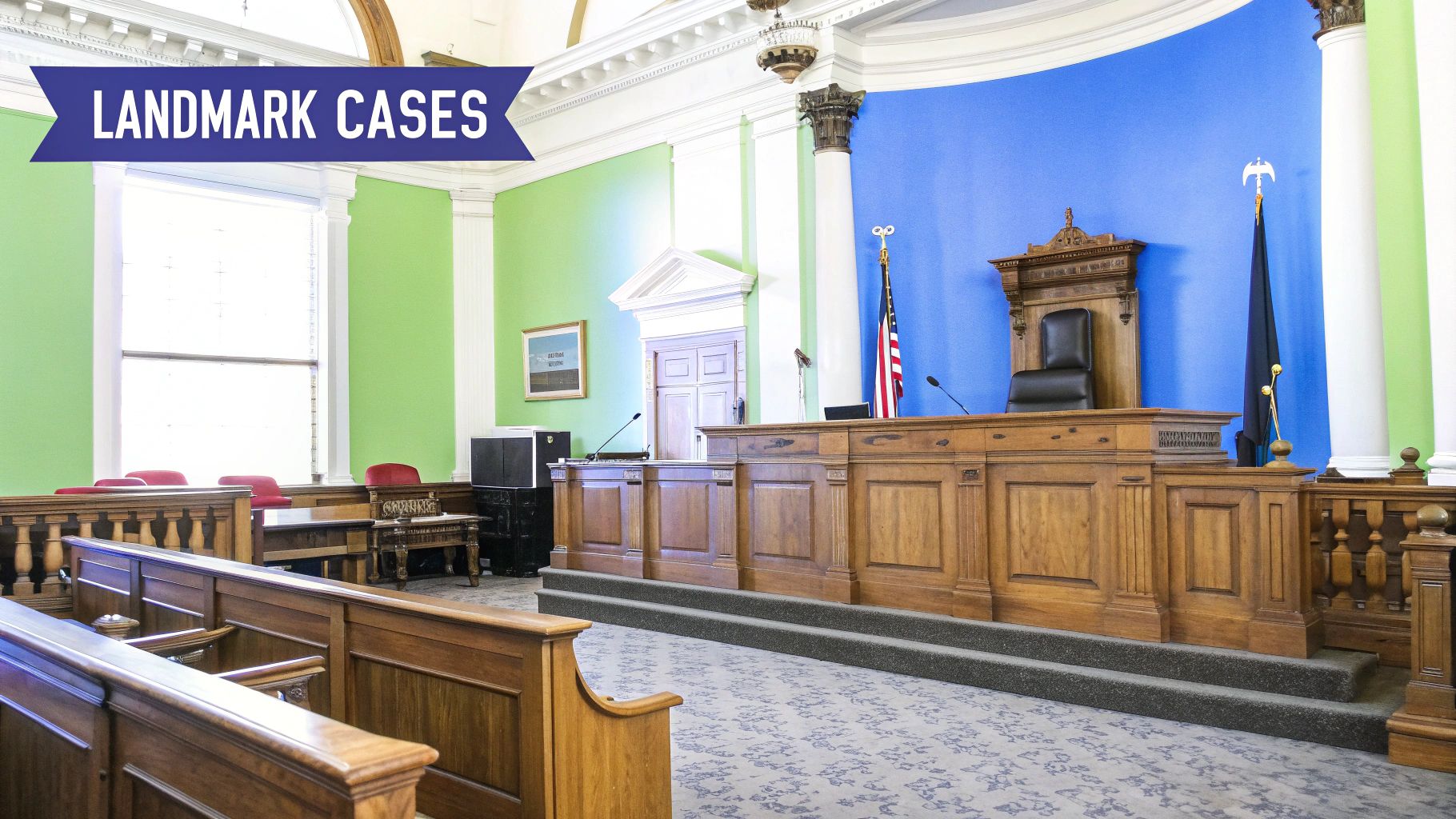
The idea of "precedent" might sound like something confined to dusty law books, but its influence is everywhere. It shapes the bedrock of our rights and dictates the daily rhythm of business. Its impact is most powerful in two main areas: constitutional law, which defines our freedoms, and contract law, which keeps commerce moving.
In constitutional law, you can think of precedent as a living history. Each time a court rules on a case involving fundamental rights, that decision adds another layer to our collective understanding of what the Constitution truly means. It’s an ongoing dialogue that stretches back centuries.
This historical conversation is vital. Studies have found that since the U.S. Supreme Court began, historical precedent has been cited in 20-30% of constitutional cases, especially those that define the scope of individual rights and government power. You can see a deeper analysis of historical precedent in constitutional cases to get a sense of how past rulings guide legal thinking today.
The Lifeblood of Business and Contract Law
In the business world, precedent isn't an abstract theory—it's the engine of predictability. When two companies sign an agreement, they do so with the expectation that the terms mean something stable and consistent. That stability comes almost entirely from precedents set in past contract disputes.
Think about these common business phrases:
- "Breach of contract": Past rulings have established what kind of actions are serious enough to violate an agreement.
- "Good faith": Precedent gives us a working definition of what fair dealing actually looks like in practice.
- "Reasonable notice": Court decisions have created standards for how much warning you need to give to end a contract.
Without precedent, the definitions of these critical terms could change with every lawsuit. It would be nearly impossible for businesses to manage risk. Precedent provides the reliable guideposts that allow companies to draft agreements with confidence.
Turning Precedent into a Business Advantage
This predictability is where the real value is for any business owner or manager. When you understand the case law surrounding specific contract clauses, you can make a very educated guess about how a court would interpret your own agreements. This foresight is a powerful tool.
It lets you draft stronger contracts from the start, negotiate more favorable terms, and spot potential legal traps before they spring.
Knowing the precedent behind your obligations is a fundamental part of effective risk management. It’s also a key component of smart contract compliance management, making sure your company follows not just the words on the page but their established legal weight. By keeping an eye on relevant precedents, you can make smarter decisions, cut down on legal spend, and operate with more certainty.
Answering Your Questions About Legal Precedent
It's one thing to talk about legal precedent in theory, but what does it actually mean in the real world? The line between judge-made law and the laws passed by legislatures can feel a bit blurry, and its day-to-day impact isn't always obvious. Let's tackle a few common questions to make this critical legal concept crystal clear.
This FAQ will unpack some of the most practical questions people have when they first start digging into legal precedent.
How Is Precedent Different from a Law?
This is a great question because it cuts right to the core of how our legal system works. Think of it like this: laws, which are also called statutes, are the official rules written by legislatures like Congress or a state government. They're the rulebook.
Precedent, on the other hand, is case law. It’s the law created by judges when they have to interpret those statutes and apply them to messy, real-world situations. A statute might say "theft is illegal," but decades of precedent will define what that actually means for everything from stealing a company car to digital assets and intellectual property.
Can a Court Ignore a Precedent?
Ignoring a binding precedent is a big deal and almost never happens. If a lower court just decides to disregard a ruling from a higher court, its decision will almost certainly be overturned on appeal.
But courts do have a very powerful tool: they can "distinguish" the facts of the case in front of them from the one that set the precedent. This is a subtle but important move. It involves arguing that the previous ruling doesn't apply because the current situation is fundamentally different in some key way.
Overturning a precedent entirely is a massive legal earthquake. It’s typically reserved for situations where legal principles or societal values have evolved so significantly that the old ruling is no longer just or workable, as seen in the landmark Brown v. Board of Education case.
Do All Countries Use Legal Precedent?
No, not all of them. The heavy reliance on precedent is a hallmark of common law countries. This group includes:
- The United States
- The United Kingdom
- Canada
- Australia
In contrast, civil law countries—like France, Germany, and Spain—put their faith in comprehensive legal codes drafted by legislatures. While judges in those systems might look to past decisions for a bit of guidance, they aren't bound to follow them in the same way.
Why Does Precedent Matter for My Business?
If you want the one-word answer, it’s predictability.
Understanding how courts have ruled on business disputes in the past, especially in contract law, gives you a massive strategic advantage. It creates a reliable framework for you to anticipate how a judge might interpret your company’s contracts and responsibilities. This knowledge helps you draft stronger, clearer agreements from the get-go and actively manage your legal risk before it ever becomes a problem.
Navigating the precedents that shape your contracts is key to protecting your business. Legal Document Simplifier uses AI to analyze your agreements, highlighting key terms and obligations that have been defined by years of case law. Stop guessing what your legal documents mean and visit https://legaldocumentsimplifier.com to see how you can get clarity and confidence in seconds.